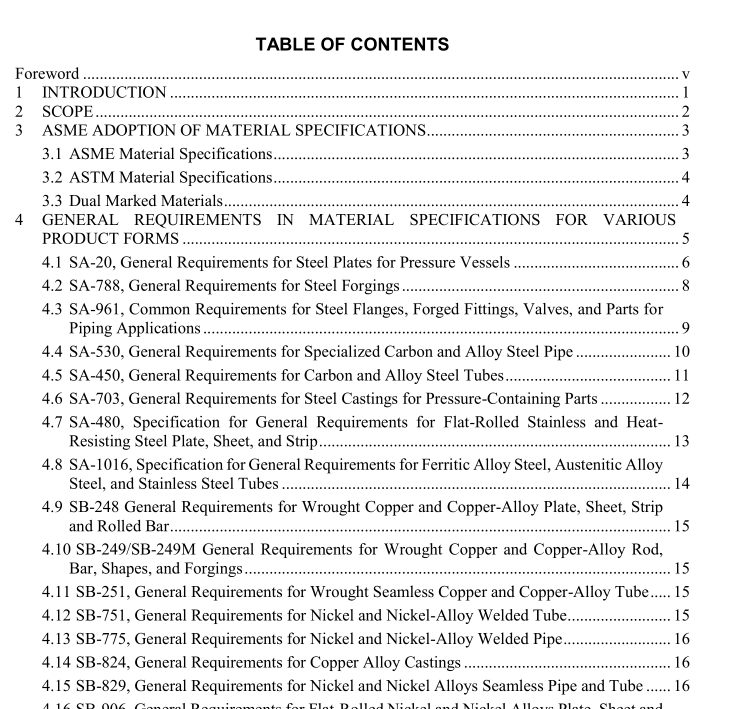ASME PTB-8:2014 pdf free download PROCUREMENT GUIDELINES FOR METALLIC MATERIALS
3ASME ADOPTION OF MATERIAL SPECIFICATIONS
ASME material specifications are those that are published in the BPVC Section lI, Parts A, B and C.The majority of ASME material specifications are based on ASTM or AWS specifications.
ASME ferrous material specifications are identified by the letters “SA” as the first characters in thespecification number. For example, SA-106 refers to an ASME specification, whereas A106 refers toan ASTM specification. ASME nonferrous material specifications are identified by the letters “SB” asthe first characters in the specification number. For example, SB-366 refers to an ASME materialspecification,whereas,B366 refers to an ASTM material specification. ASME welding rod, fillermetal, and electrode material specifications are identified by the letters “SFA” as the first characters inthe specification number. For example, SFA-5.1/SFA-5.1M refers to an ASME specification, whereas,A5.1/A5.1M refers to an AwS welding material specification.
As ASME adopts ASTM and other acceptable international material specifications for pressure vesselconstruction, the requirements in the ASME specification generally will be the same as those in theadopted ASTM or the acceptable international specification. However, some of the ASME materialspecifications include a statement underneath the title of the specification that lists the exceptions fromthe ASTM(or international) specification, or additional ASME requirements. Users should consult theappropriate specification to determine the differences between the ASME and the ASTMAWS (orother international) specifications.
3.1 ASME Material Specifications
In general, materials used for ASME BPVC construction are required to be ASME materials.TheBPVC Section ll, Part D, Tables 1A,1B, 2A,2B,C,5A and 5B list all materials that may be used forASME Code construction.Materials that have a temperature listed in the column titled “Applicabilityand Maximum Temperature Limits”may be used for ASME Code construction within the indicatedtemperature range for the applicable BPVC Section. Materials that have“NP” listed in this columnmay not be used for construction under that Section. Materials that are not listed in the BPVC Sectionll, Part D, may be used for ASME Code construction if permitted by an ASME Code Case.
The materials used for ASME Code construction must be furnished in accordance with thespecifications listed in BPVC, Section II. The materials for Code use shall be ordered, produced, anddocumented in accordance with either the ASME specification in Section lIl (except as limited by therules of the applicable construction code), or with an ASTM specification listed in Table II-200-1, orwith a specification issued by other acceptable non-ASTM (international) specifications listed in TableII-200-2, or in a ASME Code Case for the construction code(s) listed in the ASME Code Case.
The ASME SA material specifications include a statement under the title of the specification thatidentifies the related ASTM or the international material specification.Many ASME SA materialspecifications are identical with a particular edition of the same ASTM specification, in which case theASME SA specification statcs that the ASME SA specification is identical with the ASTM or theinternational material specification, and lists the year date of the publication of that specification thatis used for adoption of it as the ASME SA material specification. However, not all of the ASME SAmaterial specifications are identical with the ASTM or the related international material specification.ln such cases the statement under the title of the ASME SA specification also lists the exceptions, ormodifications,or additional requirements to the adopted specification for use in ASME Codeconstruction.For example, the ASME SA specification SA-335 adds hardness requirements for GradesP23 and P911 pipes. Another example is fusion welded pipes under specifications SA-671 and SA-672 that include an additional statement that limit fabrication of such pipe for ASME Section lIl
ASME PTB-8:2014 pdf free download
